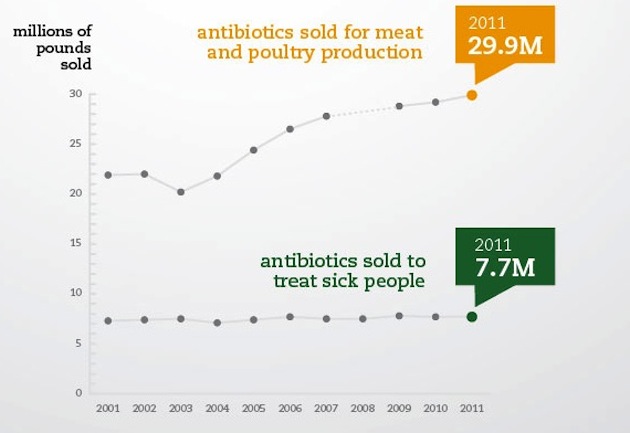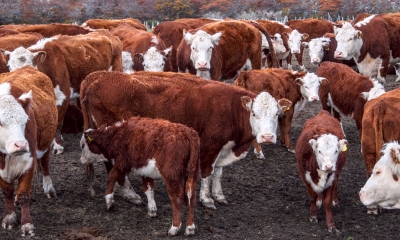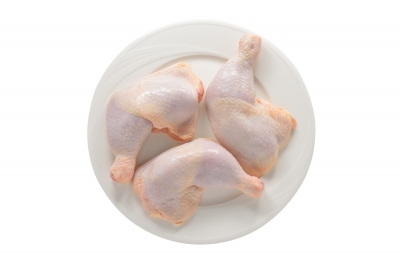
As a child, I never left the doctor’s office when sick without a prescription for antibiotics. Little did I know back then that the use of antibiotics is not limited to treatment of human health. In fact, antibiotic sales are far greater for livestock use then to treat human illness. ((http://www.motherjones.com/tom-philpott/2013/02/meat-industry-still-gorging-antibiotics)). On October 10, 2015, California became the state with the strictest law on livestock antibiotic caused by the increase in superbug resistance to antibiotic treatment. ((http://bullhorn.nationofchange.org/california_enacts_strict_animal_antibiotic_law))
What are antibiotics?
Antibiotics are used to fight bacterial infections. They were developed in the 1920s and revolutionized modern medicine. ((http://www.cdc.gov/getsmart/community/about/index.html)) There are two types of antibiotics: broad and narrow spectrum. Narrow spectrum antibiotics are designed to kill only a few types of bacteria in the body, whereas broad-spectrum antibiotics do the opposite. ((http://www.nps.org.au/medicines/infections-and-infestations/antibiotics/for-individuals/what-are-antibiotics-and-how-do-they-work)) The word antibiotic comes from the Greek “anti” meaning to “against” and “biotic” meaning “life”. ((http://www.medicalnewstoday.com/articles/10278.php))

Why are antibiotics used in livestock production?
If you have ever driven by a feedlot, such as Harris Ranch on I-5 in California, you understand why antibiotics are used in livestock production. Overcrowding of animals spreads disease and infection. It’s not just to prevent illness from unhealthy living conditions, these important medicines are also used to fatten the animals.
The Union of Concerned Scientists explains:
While some uses of antibiotics in livestock operations are a matter of animal health, other uses have an economic motive. Especially troubling is their use not to cure sick animals but to promote “feed efficiency,” that is, to increase the animal’s weight gain per unit of feed. These drugs are also regularly added to the feed and water of animals that are not sick in order to prevent diseases caused by overcrowded and unsanitary CAFO conditions. These nontherapeutic uses translate into relatively cheap meat prices at the grocery store. ((http://www.ucsusa.org/food_and_agriculture/our-failing-food-system/industrial-agriculture/prescription-for-trouble.html#.Vh8YLFxurzI))
What is antibiotic resistance?
The overuse of antibiotics both in the human and animal populations has caused their efficacy to diminish. For humans, unfortunately, antibiotics have often been wrongly prescribed for viral infections. For animals, use in healthy animals has enabled resistant bacteria to be transferred to humans through food consumption.
Antibiotic resistance is real. I personally experienced it a few years ago when I had strep throat. The typical treatment of penicillin had no effect. I developed an abscess on my tonsil. It would not respond to any antibiotic, intravenous or oral. I saw doctors scrambling. It was scary.

It is not only humans that experiencing the effects of antibiotic resistance, but livestock is as well. Mother Jones reports:
• Of the Salmonella on ground turkey, about 78% were resistant to at least one antibiotic and half of the bacteria were resistant to three or more. These figures are up compared to 2010.
• Nearly three-quarters of the Salmonella found on retail chicken breast were resistant to at least one antibiotic. About 12% of retail chicken breast and ground turkey samples were contaminated with Salmonella.
• Resistance to tetracycline [an antibiotic] is up among Campylobacter on retail chicken. About 95% of chicken products were contaminated with Campylobacter, and nearly half of those bacteria were resistant to tetracyclines. This reflects an increase over last year and 2002.((http://www.motherjones.com/tom-philpott/2013/02/meat-industry-still-gorging-antibiotics))
These antibiotic “superbugs” can be transferred to humans through consumption of infected meat. The Union of Concerned Scientists explains:
As resistant strains of bacteria emerge, they have easy passage to humans—right though the grocery store. Campylobacter, for example, is carried into kitchens on poultry and can cause illness when people eat raw or undercooked poultry meat. While this does not always cause severe illness, the CDC estimates that there are two to four million Campylobacter infections per year, resulting in as many as 250 deaths each year in the United States. Furthermore, about one in a thousand Campylobacter infections leads to Guillain-Barré Syndrome, a disease that can cause paralysis. Thus, the emergence of drug-resistant Campylobacter is a serious public health concern.
In fact, the use in poultry of fluoroquinolones, a precious class of antibiotics, led to the development of resistant Campylobacter strains. Before fluoroquinolones were approved for use in agriculture in the United States, no fluoroquinolone resistance was reported in people unless they had previously taken the drugs for illness or traveled to a country that permitted their use in agriculture. But after the antibiotics were approved for agricultural use, resistant strains began emerging in samples taken from both humans and poultry. The correlation of the emergence of resistance with the use in animal systems was important evidence that agricultural use was the culprit. The FDA recognized the seriousness of the threat and banned fluoroquinolones from veterinary use in September 2005.((http://www.ucsusa.org/food_and_agriculture/our-failing-food-system/industrial-agriculture/prescription-for-trouble.html#.Vh8YLFxurzI))
Considering antibiotic use in livestock far outweighs the use in treating human illness, the overuse and misuse of antibiotics in livestock production is a serious threat to public health.
The Natural Resource Defense Council sums it up well:
Did you know that 80 percent of all antibiotics sold in the United States are for use on livestock and poultry, not humans? The majority aren’t even given to animals that are sick. Instead, it’s normal practice in the meat industry to mix these drugs with livestock food and water day after day as a substitute for healthier living conditions and to make chickens, pigs, and cows grow faster.
The problem with feeding antibiotics to animals that are not sick is that it kills off weak bacteria and creates the perfect environment for antibiotic-resistant bacteria to multiply and thrive. When the meat industry routinely misuses and overuses antibiotics in this way, it threatens public health when essential drugs no longer work to treat infections. This makes us all less safe.((http://www.nrdc.org/food/saving-antibiotics.asp))
California’s new law on antibiotic use in livestock is strictest in the nation
Thankfully the legislature and governor of California has taken a stance against antibiotic use in livestock production by passing the nation’s strictest law. No longer will these important drugs used to fight human illness be allowed to be used in routine livestock maintenance.
The Nation of Change explains:
Signed by Governor Jerry Brown on Saturday, the law bans the use of medically important antibiotics to promote growth in cows, chickens, pigs, and other animals raised for profit. Meat producers will only be able to administer the drugs with the approval of a veterinarian when animals are sick, or to prevent infections when there’s an “elevated risk.” They can’t use the drugs “in a regular pattern.” The policy is more restrictive than the U.S. Food and Drug Administration’s national guidelines, which don’t restrict use for disease prevention.
Overuse of antibiotics, both in medicine and in animal agriculture, contributes to the rise of drug-resistant superbugs that kill 23,000 Americans each year and sicken 2 million. Brown vetoed a weaker bill last year. The new law is a win for consumer and environmental advocates who have sought tougher rules for years. ((http://bullhorn.nationofchange.org/california_enacts_strict_animal_antibiotic_law#sthash.5umUsNfI.dpuf))
This law is a big victory for public health. California is the third largest producer of livestock in the US.((http://america.aljazeera.com/articles/2015/10/12/alternatives-to-use-of-antibiotics-in-livestock.html))
Leave a Reply